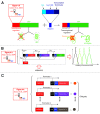Regulatory RNAs: charming gene management styles for synthetic biology applications
- PMID: 24356572
- PMCID: PMC3917981
- DOI: 10.4161/rna.27102
Regulatory RNAs: charming gene management styles for synthetic biology applications
Abstract
RNAs have many important functional properties, including that they are independently controllable and highly tunable. As a result of these advantageous properties, their use in a myriad of sophisticated devices has been widely explored. Yet, the exploitation of RNAs for synthetic applications is highly dependent on the ability to characterize the many new molecules that continue to be discovered by large-scale sequencing and high-throughput screening techniques. In this review, we present an exhaustive survey of the most recent synthetic bacterial riboswitches and small RNAs while emphasizing their virtues in gene expression management. We also explore the use of these RNA components as building blocks in the RNA synthetic biology toolbox and discuss examples of synthetic RNA components used to rewire bacterial regulatory circuitry. We anticipate that this field will expand its catalog of smart devices by mimicking and manipulating natural RNA mechanisms and functions.
Keywords: RNA regulation; RNAs and biotechnology; riboswitches; small RNAs; synthetic RNAs; transcriptional control; translational control.
Figures







Similar articles
-
Synthetic Biology of Small RNAs and Riboswitches.Microbiol Spectr. 2018 May;6(3):10.1128/microbiolspec.rwr-0007-2017. doi: 10.1128/microbiolspec.RWR-0007-2017. Microbiol Spectr. 2018. PMID: 29932045 Free PMC article. Review.
-
A high-throughput screen for synthetic riboswitches reveals mechanistic insights into their function.Chem Biol. 2007 Feb;14(2):173-84. doi: 10.1016/j.chembiol.2006.12.008. Chem Biol. 2007. PMID: 17317571 Free PMC article.
-
Expanding roles for metabolite-sensing regulatory RNAs.Curr Opin Microbiol. 2009 Apr;12(2):161-9. doi: 10.1016/j.mib.2009.01.012. Epub 2009 Feb 26. Curr Opin Microbiol. 2009. PMID: 19250859 Free PMC article. Review.
-
RNA aptamers as genetic control devices: the potential of riboswitches as synthetic elements for regulating gene expression.Biotechnol J. 2015 Feb;10(2):246-57. doi: 10.1002/biot.201300498. Biotechnol J. 2015. PMID: 25676052 Review.
-
Riboswitches in unexpected places--a synthetic riboswitch in a protein coding region.RNA. 2008 Dec;14(12):2498-503. doi: 10.1261/rna.1269008. Epub 2008 Oct 22. RNA. 2008. PMID: 18945803 Free PMC article.
Cited by
-
Integrative FourD omics approach profiles the target network of the carbon storage regulatory system.Nucleic Acids Res. 2017 Feb 28;45(4):1673-1686. doi: 10.1093/nar/gkx048. Nucleic Acids Res. 2017. PMID: 28126921 Free PMC article.
-
The Acinetobacter baumannii model can explain the role of small non-coding RNAs as potential mediators of host-pathogen interactions.Front Mol Biosci. 2022 Dec 21;9:1088783. doi: 10.3389/fmolb.2022.1088783. eCollection 2022. Front Mol Biosci. 2022. PMID: 36619166 Free PMC article. Review.
-
Identification and Characterization of 5' Untranslated Regions (5'UTRs) in Zymomonas mobilis as Regulatory Biological Parts.Front Microbiol. 2017 Dec 8;8:2432. doi: 10.3389/fmicb.2017.02432. eCollection 2017. Front Microbiol. 2017. PMID: 29375488 Free PMC article.
-
Synthetic Gene Expression Circuits for Designing Precision Tools in Oncology.Front Cell Dev Biol. 2017 Aug 28;5:77. doi: 10.3389/fcell.2017.00077. eCollection 2017. Front Cell Dev Biol. 2017. PMID: 28894736 Free PMC article. Review.
-
Discovery and Characterization of Native Deinococcus radiodurans Promoters for Tunable Gene Expression.Appl Environ Microbiol. 2019 Oct 16;85(21):e01356-19. doi: 10.1128/AEM.01356-19. Print 2019 Nov 1. Appl Environ Microbiol. 2019. PMID: 31471304 Free PMC article.
References
Publication types
MeSH terms
Substances
LinkOut - more resources
Full Text Sources
Other Literature Sources
Research Materials
